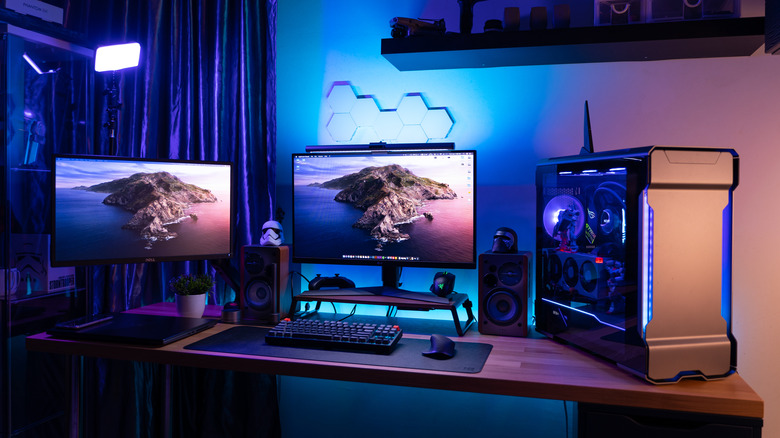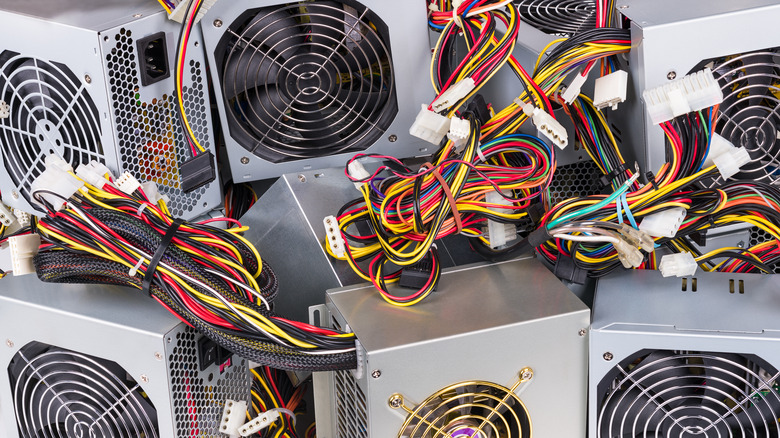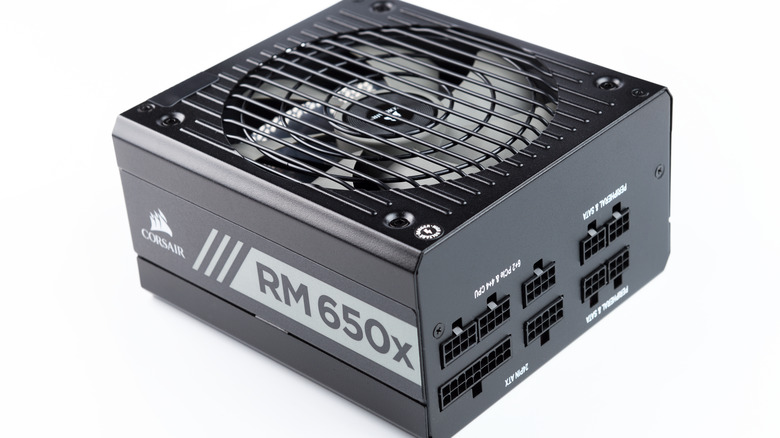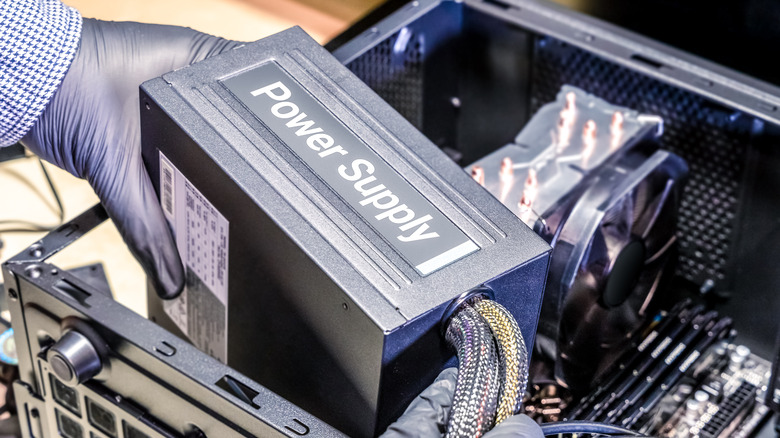Never Buy A Cheap Computer Power Supply. Here's Why
Configuring a custom gaming PC is both fun and rigorous work. First, you get to research your components –- case, motherboard, CPU, GPU, memory, storage, peripherals, cooling, and power supply unit. Each of these individual parts contributes to the greater whole, coming together to form a machine that you yourself had a hand in designing. Many PC building enthusiasts may find it easy to geek out over all of the different potential combinations of parts, especially when "theorycrafting" an optimal computer build within a certain budget, in essence, by sticking together a bunch of different parts in a Newegg shopping cart.
However, when shopping for a new PC or upgrading an existing one, a few of your chosen parts should absolutely be sturdier than the others. Specifically, you should be investing in a high-quality power supply instead of a cheap power supply whenever you get the chance. A solid, well-built power supply might not make video games and software run faster, but you can rest assured that it won't fizzle out on you, potentially causing system failure or even pose a fire risk in certain cases. When you're spending upwards of $600-1500 or even more on a new computer, you absolutely want to protect your investment, which is why we recommend never buying a cheap power supply.
Potential risks of using a cheap power supply
Cheap power supplies tend to come with low-quality components and materials, which themselves can cause unwanted and inconsistent voltage spikes. They may also have poor heat dispersal and cooling systems that are inadequate to handle high loads. Horror stories abound on websites like Reddit and Tom's Hardware, where users have repeatedly warned others to avoid low-quality power supplies that have, for instance, faulty regulation which struggles to protect PC components inside the case from power fluctuations. Older power supply units also used something called group-regulation. Power supply units that use the aforementioned group-regulation design are still sold today, even though they tend to struggle with modern computer hardware due to inconsistent cross-loading on the +12V and +5V rails, according to a few helpful users on the Super User forums.
The Register reported a particularly harrowing horror story about a computer that'd burst into flames in November 2012, in which the source's 15-year-old son wound up with a melted PC while doing his homework. As the story unfolded, it became clear that the power supply unit was the main culprit of the meltdown, and the mess left behind in the wake of the fire serves as a warning sign to all prospective PC builders.
In fact, exploding power supply units are a prominent issue even today, and they can even be found at trusted retailers. Just as recently as August 2021, Newegg sold a batch of faulty power supplies in certain GPU bundles, according to Ars Technica.
Which power supply brands you can trust
There is no 100%, surefire way to ensure that your power supply unit won't malfunction. There's always a non-zero chance that PC components break before arriving, and some components — power supply included — may even fail due to unsafe handling during installation. That said, the amount you budget is especially important to consider, seeing as how "you get what you pay for" applies extra hard when it comes to power supplies. Shopping for a modern, affordable, high-quality power supply unit can still net you a handful of reliable choices as long as you stick to a certain set of hard and fast rules. For quick reference, the safest brands to select from have historically been GIGABYTE, Corsair, Seasonic, EVGA, Antec, and Rosewill, but going by brand alone isn't enough.
Power supply price tends to correspond with wattage in addition to a few other factors. In any modern system, you generally want to start with a baseline of 450w at the very least, and then you want to scale that upward with your needs. Hand in hand with that logic, if you're building a gaming rig with a power-hungry GPU and CPU as well as a number of cooling fans to power up, you'll want to increase your baseline to roughly 750w+ and scale upward from there.
How to budget for a high-quality power supply
Modern power supply units (the safe ones!) are usually certified with something called 80 PLUS, also known as 80+. It's a universal efficiency rating that is meant to tell you how well your PSU performs under certain degrees of power load, relative to the advertised wattage, but it isn't foolproof. Those exploding PSUs we mentioned earlier were 80+ Gold certified, which speaks to the fact that even this standard of quality can't ensure absolute safety.
Usually, an example 80+ Standard 450w PSU is ensured to consistently output at least 80% of 450 watts, 100% of the time. As you start moving toward the highest-end power supplies, you'll eventually get to the 80+ Titanium rating, which promises at least 90% efficiency, 100% of the time. In most (but not all) instances, these power supplies are quality-tested and are still highly unlikely to short out or cause any sort of hazards at all, and are often quite durable — lasting for years before needing to be replaced or upgraded.
When shopping for PSUs that adhere to 80+ Standard or above, your price range should ideally sit between $75-150. If you're building a gaming PC, you'll likely also want to invest in a power supply with modular cabling that is space-efficient within your case, which means you should end up budgeting within the ballpark of around $100 to $200. It's important to mention that new power supply units are releasing all the time, and some products are simply more durable and better-constructed than others, regardless of brand or price, which means that it's still worth getting several opinions before making a final purchase. Tom's Hardware's best-reviewed power supply units of 2022 is a great place to begin weighing your options.



